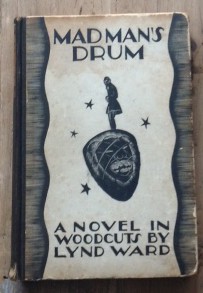Inspiring Older Readers
 posted on 24 Jan 2016
posted on 24 Jan 2016
Madman’s Drum by Lynd Ward
I was surprised and delighted to stumble on a good copy of the first edition of Lynd Ward’s Madman’s Drum in Leominster this weekend. I have some examples of Ward’s work in reprint but I’ve never seen an original 1930 version before – and it is a really superb example of book design and production.
Ward was born in 1905 and was the son of a Methodist preacher and political activist. He overcame a childhood bout of TB and despite continuing poor health he trained as an artist - this led him to meet his wife who he married in 1926. They moved to Europe to live for several years and whilst there he came across other European artists doing wordless ‘novels’ in a series of woodcuts. Inspired by what he had seen, he set out to do his own sequence of which Madman’s Drum is one of six.
The woodcuts he produced are not only splendid in their own right but the sequencing of them into a story that would need the reader to interpret them without the help of words is now seen as a crucial first step in the creation of the modern day graphic novel. Ward’s illustrations are full of symbolism and the story is carried along through both conscious and unconscious interpretation by the reader.
The book contains 118 designs each on a page by itself and typically they are around 5”x4” or smaller at 4”x 3”. All of them glow with the contrast of the black on what is in my copy a sort of creamy, heavy pearl paper which seems to enhance the blackness of the ink and gives the illustrations an almost three-dimensional presence.
I’ll leave you to interpret the story for yourself – you have to ‘read’ the pictures with real care and great patience to construct the narrative. However, I suspect that there is no single storyline here and the interpretation of each individual will vary to some degree. What is undeniable is that Ward is inviting us to think about our past (represented by slavery) and what kind of future we can have (as represented by science) whilst at the same time asking us to also think about our own human nature; whether we can or should subdue our hedonistic instincts and at what cost.
I paid £25 for my copy and I would probably have paid more because I’ve just never seen one before. Original copies on the internet might cost you closer to £100 – although reprints are available for less. I would just counsel caution on the reprints because the quality of paper and printing on the original editions are so far superior that you’ll be missing an important dimension to the experience if you go for the reprint.
Terry Potter
January 2016





